Kusoge Advent Calendar 2017: FINALE
It’s April. Nearly May. In a week, I’ll celebrate another year of not dying, despite the best efforts of the dumb fucks that let me do this to myself.
It took me 3 weeks in December to play through the games laid out for me—a roster curated to hit a perfect balance between intriguing discoveries and unexplainable failure, half archaeological dig and half public flogging. There is no reason playing video games should be this goddamn hard.
It has taken me nearly half a year to finally make a record of the experience. I’ve sat down at my editor nearly every day since then, trying to turn 21 days of 60 images per second into organized human thought. It is perhaps the least important undertaking in human history.
But today, it’s finally done.
This is the end.
#21: Touki Denshou Angel Eyes
There’s a note next to Angel Eyes on our lineup spreadsheet.
Title: Touki Denshou
Angel Eyes
Platform: Arcade
Note: The PS1 version has some “extra” “characters”. Could try that.
I stared at that line for 2 months wondering what the hell it could mean. We’ll come back to it in a minute.
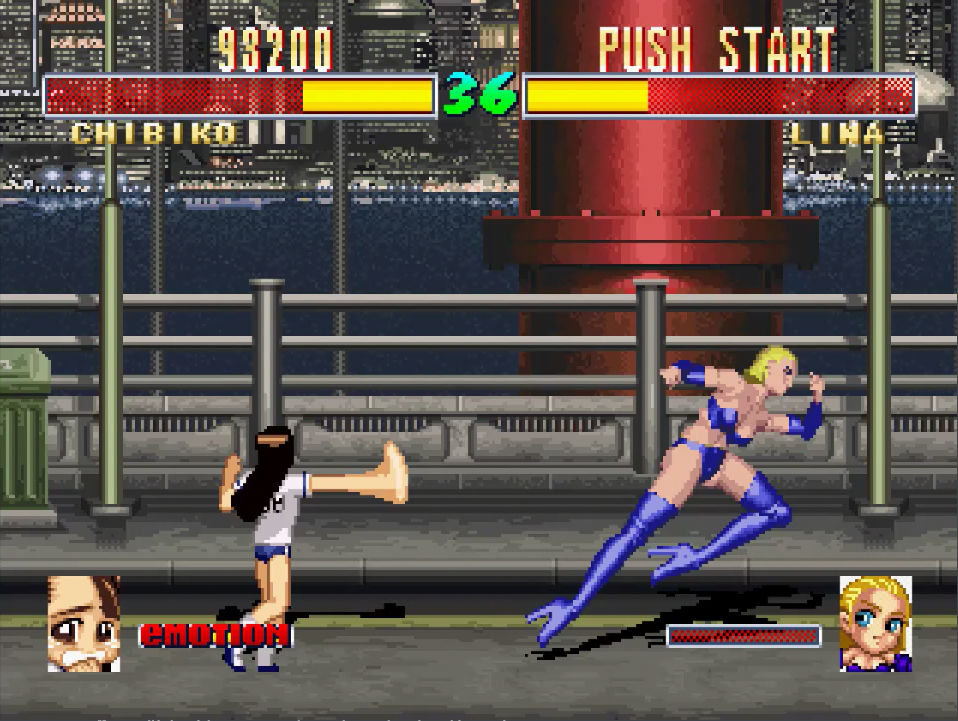
I avoided writing about Angel Eyes for a long time while I gathered my thoughts. It’s got too many interesting systems for me to just call it an unparseable brain-melter, even though it is, and it’s got way too many flaws to call it a hidden gem, even though I’ve started to think of it that way.
For a 1996 title, Angel Eyes has unparalleled freedom of movement, nailing responsive and snappy controls without feeling twitchy or difficult to control. 10 years before Arcana Heart, Taito gave us a game with double jumps, a homing dash, an all-female cast, and punishing pressure on the same level as any modern anime fighter.
It also has damage.
Maybe a little too much damage.
Angel Eyes aims to dizzy you with an unrelenting breakneck pace; nowhere is this more obvious than at round start, where it flings both characters at each other like they were launched from slingshots. The game’s art styles help push it towards this goal—and yes, that’s plural, since half the cast is sprited by hand while the other half is dithered 3D pre-renders, ostensibly to separate humans from robots. I have no idea why anyone thought this would be a good idea, but it’s a great addition to the headache-inducing cocktail.
As for the “extra” “characters”: The PS1 release added unlockable alternate versions of every pre-rendered character, identical in every way except visuals—replacing the dithered 3D with perfectly normal-looking spritework. Did they sprite half the cast just for a home port no one would ever buy? Or did they have the assets all along, but decide not to use them in an inexplicable moment of mass psychosis? Either option is sort of troubling.
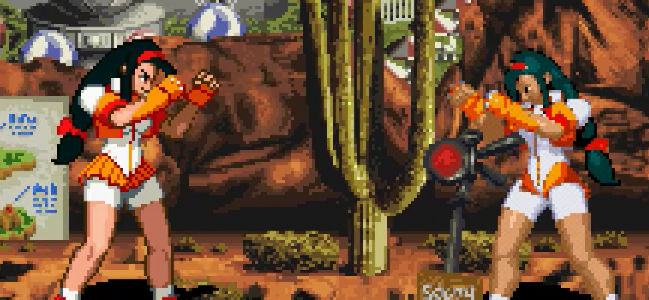
They didn’t bother adding pre-rendered versions of the sprited characters. I can’t possibly imagine why.
VERDICT: REAL-ASS
Keegan: This game fascinates me. Between the absolute nonsense that is the handful of pre-rendered characters, the inclusion of sprite versions of those characters on the console version, and the fact that this game has Arcana Heart movement with Super Turbo damage and came out in friggin’ 1996? Tecmo, I don’t know what you were doing, but it was simultaneously way ahead of its time and somewhere to the left of it. This is the kind of experimentation that makes the era of Way Too Many 2D Fighters so interesting to dig through.
Sleepmode: Did you know that this game is on Fightcade? I thought that was interesting
#22: Touhou Hisoutensoku
Hisoutensoku was the game that introduced me to poverty fightan many, many years ago, so it’s fitting that it was my only respite during the finale. It’s always held a special place in my heart—powerful but accessible movement, combos that are just long enough to reward smart conversions, a novel approach to defense, and a fantastic arranged soundtrack.
It also has systems that make Danger Time look like chess. Why else would it go on this list?
Everything in Soku centers around Spirit; it’s a regenerating flight meter, guard gauge, and ammo system all at once, regulating almost everything but basic movement and attacks. It gives the game a natural flow, a simple push and pull that’s easy to understand even for newcomers—push too far on offense and you’ll run out of steam, vulnerable to a guard crush.
Both players also have a 20-card deck, assembled from a long list of supers, special move modifiers, and universal “skill” cards. In place of a traditional super meter, you draw cards, cycling through the list to select your attacks. Your hand’s visible to both sides, though, and your active card is always highlighted; there’s something kinda cute about holding a powerful reversal in plain sight, daring your opponent to try something.
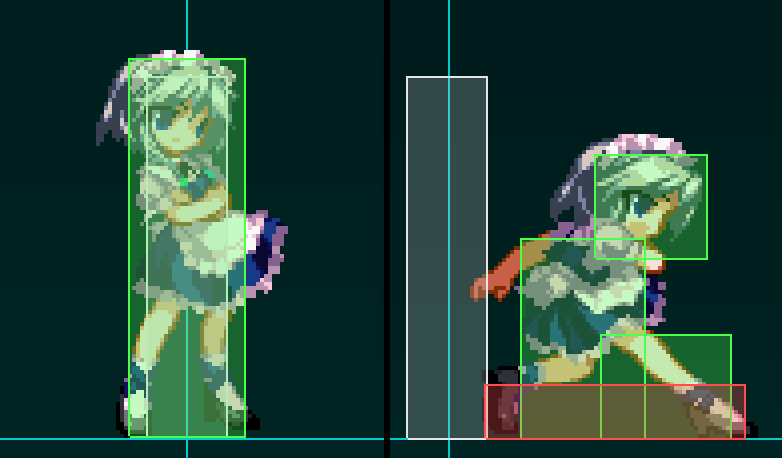
I’ll gladly shill for every system in Soku, except for one. See, in place of what should probably be a match timer, Soku tracks the weather, cycling between “clear” weather and a long list of unusual effects—the type of shit that makes a better NFL Blitz cheat than fighting game mechanic. Here’s a sampler:
- Guard cancels are free
- Heal half the damage you deal
- Dashing is invincible
- Ground teching disabled
- Gain an extra airdash
- KOF13’s HD mode
- Everything counterhits
- Everything wallslams
- Everything guard crushes
- UNCONDITIONAL SUPER ARMOR, BLOCKING DISABLED
The weather is on a set cycle, and you can speed up transitions by playing aggressively, but there’s no way to stop certain effects from turning the game into a meme scramble, or desyncing netplay if your name is Hong Meiling. Yes, this actually happens—a mechanic so bizzare and unnecessary that it breaks a totally unrelated system. I like Soku, but if I’m being honest, I can only classify it one way.
VERDICT: REAL-ASS
Zari0t: I want the runback.
Sleepmode: All I know about this game is that the southern hemisphere’s best player apparently resides in Australia.
also IaMP is better
Keegan: I like the frog. The frog is good.
#23: Sango Guardian Chaos Generation
The precise meaning of “hot dog with everything” is regional. In Seattle, you might get cream cheese and sriracha. In North Carolina, it might be cole slaw and chili. In Chaos Generation, you get tomato, onions, relish, pickles, ketchup, mustard, chili, mayo, cheese, peppers, french fries, sauerkraut, bacon, pulled pork, fried chicken, coleslaw, an entire cheeseburger, a half-rack of ribs, 6 dollars in quarters, and a map to the lost city of Atlantis.
If you’ve got the stomach for it, it’s worth a try.
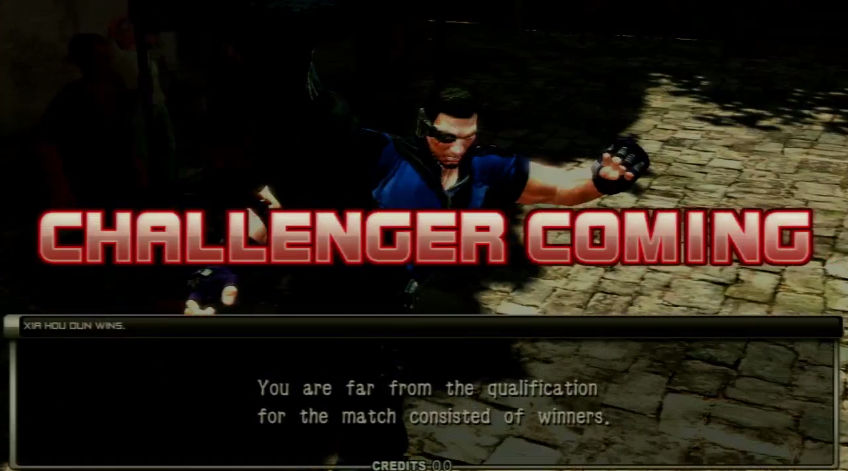
Sango Guardian Chaos Generation comes to us from Guangzhou Sealy Electronic Technology Co., a Chinese ticket-redemption game manufacturer. As far as I can tell, this is their first and only foray into fighting games, or actual video games of any kind. I could be wrong, though, since their official site doesn’t even bother to list Chaos Generation. My current theory: the Guangzhou Sealy Actual Games Division is two dudes in a storage closet who never got taken off payroll.
The game looks like bootleg SF4, featuring a handful of blatantly stolen animations, and shares a handful of its mechanics. When I first saw Chaos Generation in action, I assumed that was all there was to it. Then somebody activated MAX mode, airdashed in for a deep overhead, launched their opponent and started looping an aerial magic series. That’s when I knew we were dealing with something special.
It’s a fighting game chimera: not just Focus Attacks and Ultras, but Under Night’s autocombos, SF3’s parries, Marvel’s double jumps and airdashes, one-button proximity throws and two-button explicit throws, and almost every mechanic that has ever appeared in a KOF game, including hops. Oh, and it’s got a universal Vampire Savior-style hopdash, except you can only do one normal out of it and you input it with 222, which I’m choosing to interpret as teabagging mitigation.
With every mechanic under the sun packed in, plus fast walk speed and snappy buttons, the end result has a surprising degree of freedom. It actually feels really good to play—which is almost unfortunate, because it has no netplay, no support for multiple controllers, and takes well over 5 minutes (!!!) to launch from an SSD. On a technical level, it’s a goddamn mess beyond almost anything I’ve seen in these marathons. If I ever spent more time with it, it would have to be on a dedicated arcade kit, because I don’t really want it anywhere near my PC.
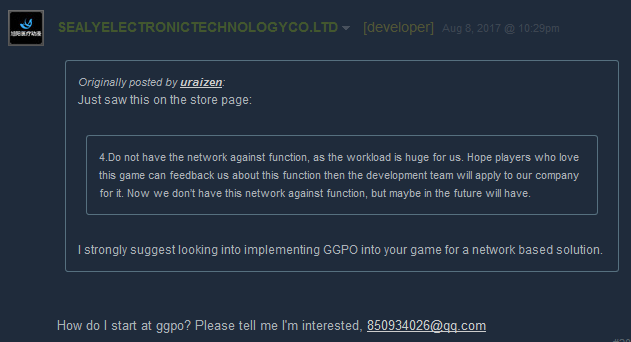
Despite that, Chaos Generation is an experience any fighting game fan should have at least once. A casual glance makes it look like a second-rate bootleg, but the combination of a thousand rough edges makes it feel like something else entirely. At the very least, watch some match footage, because nothing I write here can compare to seeing this…thing in motion.
VERDICT: REAL-ASS VIA CHAOS GENERATION ESCAPE CLAUSE
Sleepmode: This is one of two fighting games that I created wikis for. However, unlike Kamen Rider Super Climax Heroes, which I sank countless hours into because I wanted to see just how many memes I could get from it, I’ve spent an inordinate amount of time with Chaos Generation because I really, genuinely love it. Everything about this game screams “earnestness”. An unmistakably Chinese hodgepodge of animation assets lifted from Street Fighter X Tekken and game mechanics lifted from just about everywhere else, Chaos Generation is, to me, the most pure and honest embodiment of the spirit of poverty fighting games. It’s a love letter to every fighting game the developers have ever held dear (which is, like, at least 80% KOF ‘97), with each of its inspirations’ constituent parts thrown together with such reckless abandon that it comes together in a way that is something entirely different from the sum of its parts, but something more all the same.
Keegan: I can’t possibly knock anybody who loves The King of Fighters this much, even if they also love Street Fighter 4 just as much. I’m glad we live in a world where whatever this is can exist to some extent.
#24: Mizuki Shigeru no Youkai Butouden
Last year, in a marathon a lot like this one, I named Dragon Ball GT: Final Bout as my least favorite game of all time. It’s a licensed PS1 title with unbearably stiff controls, horrible character models, unfinished backgrounds, an unplayable framerate, and a mess of thrown-together music and sound effects. It’s a licensed game given no budget and no time, a story we’ve seen a thousand times before, and the result is only noteworthy in how badly it fails.
In a lot of ways, Mizuki Shigeru no Youkai Butouden is the same thing—a licensed PS1 trash fire—but without anything remotely familiar to latch onto, staring into a funhouse mirror of a foreign culture, the experience is very, very different.
I don’t even know where to start with this fucking…thing. It’s a PS1 title, featuring Japanese mythological creatures impotently flailing at each other in a way that may or may not be connected to your controller inputs. It takes nearly a full second to even start any action, including walking, and even longer to stop; add the inexplicably long startup on attacks, every one slow enough to be a Tekken unblockable, and the result is an uncontrollable non-game on the same level as Deadly Alliance.
Besides some ranbu supers that I was never able to trigger on purpose, the only combos come from the game’s special move macros, which are the only way to cancel normal attacks. Naturally, you’re rewarded with infinites if you can somehow stop gawking long enough to hitconfirm. Can you buffer the cancels? Maybe, but if you think I’m opening it again to check you’re fucking delusional.
Youkai Butouden earns the coveted TyroneSama Seal Of Unparalleled Galactic Motherfuckery for its two boss characters, who are playable only with random select. Sure, the game is so far past playability that they may as well not exist, but the idea counts for a lot, considering it’s the only thing about this game that didn’t make me consider self-immolation.
This has Shigeru Mizuki’s name on it—a manga artist famous for his adaptations of Japanese folklore—and I’m not really sure how it happened. The best resources I’ve turned up on this game are empty wiki pages and a single lucid article, alone in the wilderness that is the second page of Google. This apparently isn’t the first licensed Shigeru Mizuki game, either, but documentation on the others seems almost as scarce…
I don’t fucking know. I think about this game and I feel like my brain is slowly sliding down a wall made of Teflon. Earlier in the month, I insisted that Digimon Battle Spirit wasn’t a fighting game, but my time with that game was still identifiably with a game. Youkai Butouden plays like a DVD menu and feels like a nightmare.
VERDICT: ASS
Zari0t: This looked like it had a reasonable amount of love and care put into it. It’s kinda sad it ended up being…well, this. I wonder what it would’ve looked like if it had more competent development to it, the idea of monsters of japanese folklore duking it out is honestly pretty unexplored.
I’m still not over boss characters being selectable via random select. That’s a GoodFightingGameIdea right there.
Keegan: Y’all better thank me for noticing that the bosses were in that random select reel.
Abbock: sometimes, people hear “dragonball gt final bout has the stiffest controls of any ps1 fighting game” as a warning to stay away from it. I hear it as a challenge.
Shoutouts to Melv for providing the only working ISO of this game.
#25: Fight of Gods
There was no game more fitting for our finale than Fight of Gods—not just because you can play as Jesus and Santa, completing our December advent calendar, but because in a marathon full of fatally flawed games, our Island of Misfit Toys, Fight of Gods commits the only possible remaining sin. It fails at being bad.
Like many people, I first found Fight of Gods through the Jesus 2A infinite. It’s so goddamn basic that it piqued my interest—there’s really no trick to it, just jab walk jab walk jab. I’ve heard of plenty of fighting games with weird mythological premises (does Primal Rage 2 count?), but it’s rare to see a fighter with relatively high production value completely forget about the existence of pushback. I’ve played way dumber games that still show some awareness of how to prevent idiot loops.
It almost seemed a little too perfect. I probably should have listened to that instinct, because by watching the video above, you have experienced 95% of Fight of Gods. JESUS PUNCH BUDDHA HAHA.
The whole thing has a bizzarely sterile feel. Character models are pretty high-quality, but hit effects are muted and animations are painfully stiff, giving it an uncomfortable resemblance to Play Store asset flips. Combo rules are lenient enough to allow for long, annoying loops, but never quite broken enough to allow for smooth experimentation (microwalk infinites were removed in the build I played, no fun allowed). And it wouldn’t be a TyroneSama This Game Feels Like Shit Dossier without complaining about the movement, a crushingly basic system with slow walk speeds and atrocious moonjumps.
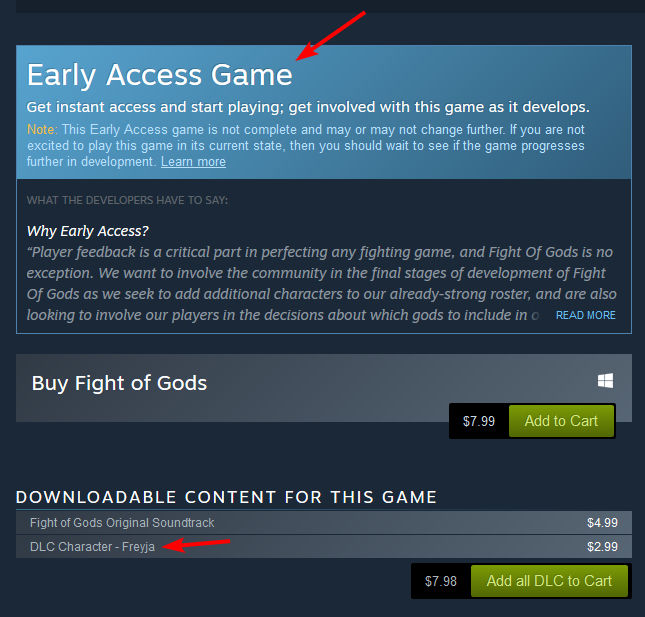
In truth, it’s forgettable. I couldn’t even write about it without re-watching the finale stream. I’ll never forget Angel Eyes, and I’ll never succeed in forgetting Youkai Butouden, but I came away from a few hours of Fight of Gods without much of an impression at all—and considering it’s a fighting game where Zeus can fight Anubis on the bed of the Red Sea, that’s almost an achivement on its own. It’s an 8-dollar vehicle for a joke that lasts 8 seconds.
Fight of Gods looks kinda bad and it plays kinda bad, but nothing about it was allowed to be shitty enough to elevate it beyond…well, bad. Despite controversy over blasphemy and regional bans, publisher trying desperately to to bank on how wacky and weird it is, it’s neither a great success nor spectacular failure—forgotten, discarded, and ultimately without purpose.
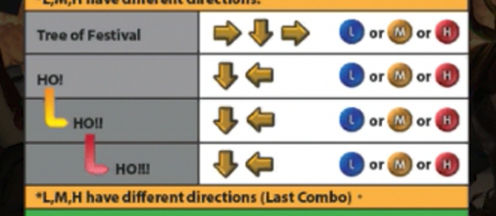
VERDICT: ASS
Sleepmode: Kinda ironic that a game whose playable cast consists entirely of spiritual figures could be so soulless.
Keegan: Capitalism ruins everything. Even kusoge.
Zari0t: I won a Super Sonico figure thanks to this game.
The marathon officially ended on the 21st—4 days before Christmas. After a scant few hours of sleep, I packed my bags and flew out to an undisclosed location in the Midwest, spending Christmas with my family. Our family holidays are usually a week-long ordeal, full of preparation and pleasantries; this time, it was a welcome retreat from the month of kusoge, barring a few troubled naps in the terminal, dreams full of polygonal turtles and tie-wielding redheads.

In the end, I couldn’t have asked for a better roster. A game that’s had all its rough edges filed off might be perfectly balanced, but it’s also boring—and that goes triple for fighting games, titles that are cooperative bullshit-finding exercises just as much as they’re competitive pursuits. Even in a long list of games picked specifically for how fucked up they are, I guarantee that every single one was once someone’s favorite. Maybe I’ve inspired you to try some of them too.
The Kusoge Advent Calendar isn’t just about finding the worst fighting games on the planet; it’s about taking those games and finding the best out of each them, even if it’s just a stray frame or a single story. It’s about celebrating a genre and a community with a long, lush history, full of false starts and blind expeditions.
It’s also about making me suffer.
| REAL | REAL-ASS | ASS | ??? | |
|---|---|---|---|---|
| Abbock | 1 | - | 4 | - |
| Keegan | - | 6 | 2 | 1 |
| Sleepmode | - | 1 | 2 | - |
| Zari0t | 2 | 1 | 4 | - |
| A Group Effort | - | - | 1 | - |
| Total | 3 | 8 | 13 | 1 |
I’m an optimist, but I’m no saint. Most of these games are hot fucking garbage, and I cannot recommend them to anyone without severe caveats. If any of them were still sold in stores, the state of California would probably plaster them in warning stickers.
Sometimes I look forward to the end of these marathons as much as the start, and if I ever have to set up a PS1 emulator again, it will be too soon. But for now, it’s over, the record is made, and I feel a strange sort of pride. The deed has been done—and until next December, I can rest easy.
Maybe.